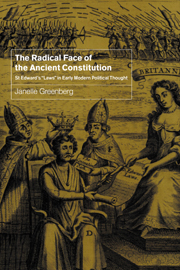Book contents
- Frontmatter
- Contents
- Acknowledgments
- 1 Hagiography and historiography: the long shadow of Edward the Confessor
- 2 “Those most noble and equitable laws of St. Edward”: from the cult of the Confessor to the cult of the Confessor's laws
- 3 “Divers and sundry ancient histories and chronicles”: the articulation of the ancient constitution in the Tudor period
- 4 “By lex terrae is meant the laws of St. Edward the Confessor”: the footprints of the Saxons in the early seventeenth century
- 5 “You shall be king while you rule well”: the radical ancient constitution in the civil wars and interregnum
- 6 “That noble transcript of the original contract, the Confessor's laws”: the radical ancient constitution in the late Stuart period
- Bibliography
- Index
1 - Hagiography and historiography: the long shadow of Edward the Confessor
Published online by Cambridge University Press: 29 August 2009
- Frontmatter
- Contents
- Acknowledgments
- 1 Hagiography and historiography: the long shadow of Edward the Confessor
- 2 “Those most noble and equitable laws of St. Edward”: from the cult of the Confessor to the cult of the Confessor's laws
- 3 “Divers and sundry ancient histories and chronicles”: the articulation of the ancient constitution in the Tudor period
- 4 “By lex terrae is meant the laws of St. Edward the Confessor”: the footprints of the Saxons in the early seventeenth century
- 5 “You shall be king while you rule well”: the radical ancient constitution in the civil wars and interregnum
- 6 “That noble transcript of the original contract, the Confessor's laws”: the radical ancient constitution in the late Stuart period
- Bibliography
- Index
Summary
INTRODUCTION
When present-day visitors to the Houses of Parliament pass through St. Stephen's Hall, which connects medieval Westminster Hall with the Central Lobby and the House of Commons, they see on its walls a series of large murals centered around the theme “The Building of Britain.” Created in 1927, these paintings portray scenes associated with the history of parliament in general and the House of Commons in particular. Visitors who know their English history will appreciate the inclusion of depictions such as Sir Thomas More's refusal to grant Henry VIII a subsidy without proper debate in the Commons. And the very knowledgable will associate St. Stephen's Hall itself with the history of parliament, since St. Stephen's Chapel served as the meeting place of the Commons from 1547 until the great fire of 1834.
However, the meaning of the huge mural above the entrance to St. Stephen's Hall will require clarification even to the most erudite of visitors. A reproduction of a portion of the Painted Chamber associated with Henry III (1216–1272), it depicts three figures: St. Stephen in the center, his namesake King Stephen (1135–1154) to the right, and St. Edward the Confessor (1042–1066), the penultimate Saxon ruler before the Norman conquest and the only English king ever to be canonized, to his left. The presence of the two Stephens makes sense in a room devoted to the history of parliament. And Holy Edward's representation is understandable given Henry III's utter devotion to his patron saint.
- Type
- Chapter
- Information
- The Radical Face of the Ancient ConstitutionSt Edward's 'Laws' in Early Modern Political Thought, pp. 1 - 35Publisher: Cambridge University PressPrint publication year: 2001



